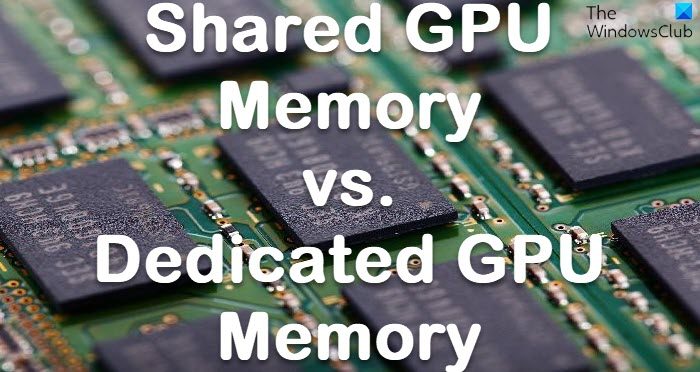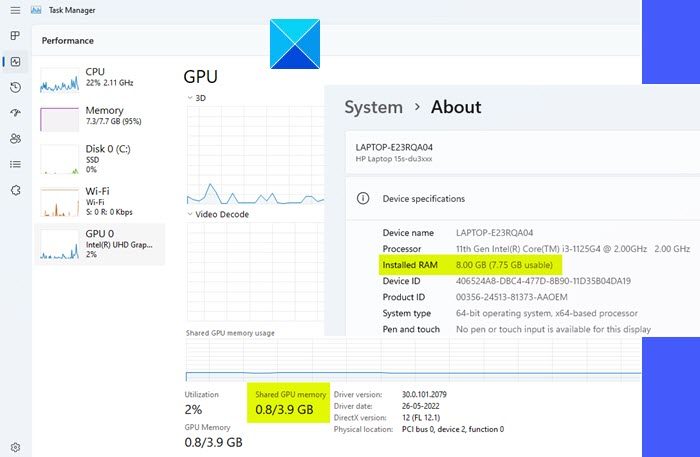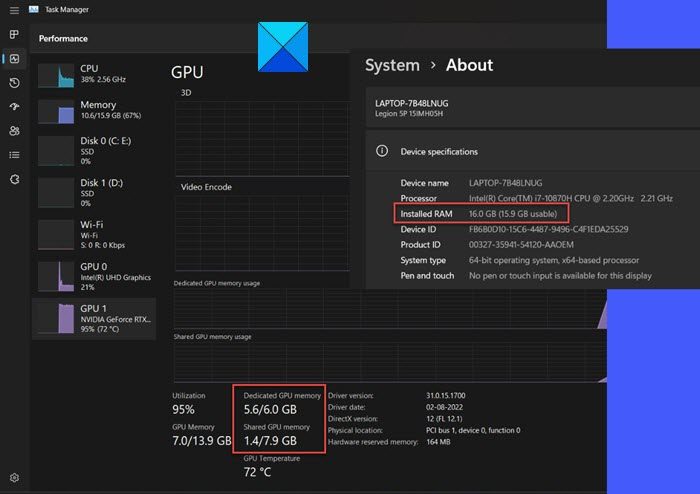If you want to know the difference between shared GPU memory and dedicated GPU memory, read this post. GPUs have become an integral part of modern-day computers. While initially designed to accelerate 3D graphics workloads, they have emerged as a fundamental computing technology for a wide range of applications, such as creative production, gaming, and machine learning.

GPUs come in 2 basic variants: Integrated (shared) and Dedicated. A dedicated GPU comes with its own discrete card. It has its own graphics memory (known as VRAM) and is connected to the main motherboard through a dedicated slot. An integrated GPU, on the other hand, is embedded within the motherboard alongside the CPU. It does not have its own RAM. It shares the system memory with the CPU.
Most modern processors nowadays come with integrated graphics. They are compact, energy-efficient, and less expensive as compared to dedicated graphics. However, dedicated graphics have more power to handle high-end gaming and complex computing. This is because they have their own physical memory (high-speed modules) located close to the GPU cores, which makes the processing faster.
What is a Dedicated GPU Memory?
Dedicated GPU Memory or VRAM (Video RAM) is a type of Random Access Memory designed specifically to store graphics-related information. It is the main component of the dedicated graphics that enables the GPU to perform high-intensity graphics tasks quickly and efficiently.
What is a Shared GPU Memory?
Integrated graphics do not come with their own exclusive memory. They ‘source’ the memory from the system’s RAM. The OS also allocates some part of RAM to be used by the dedicated GPU when it runs out of its own memory.
So, Shared GPU Memory is a virtual memory (an allocation of RAM) used by the integrated GPU or the dedicated GPU to handle graphics-intensive functions on a computer system.
Shared GPU Memory Vs Dedicated GPU Memory, which is better?
Whether you have an integrated GPU or a dedicated GPU, your system will allocate up to 50% of your system’s memory to be used as Shared GPU Memory.
To understand this, have a look at the following image:

The above device has 8GB of system RAM, of which ~4GB is reserved as shared GPU memory. When the graphics chip on this device uses a specific amount of RAM for its own need, that amount of RAM will become unavailable for other applications, eventually causing the device to operate at a much slower rate.
Now have a look at the following image:

The above device has NVIDIA GeForce RTX 3060 graphics card installed. It has 6GB of VRAM exclusively available for storing image-related data. Apart from this, the OS has also reserved 8GB of RAM (half of the system’s 16 GB of RAM) to be used as shared GPU memory. This 8GB of RAM will remain available for other applications until the VRAM is full. Once the GPU runs out of the VRAM, it will use this extra 8 GB of system memory to perform graphics-related tasks.
Whether or not you really need a graphics card with dedicated memory depends upon the type of applications you want to run on your PC. If you want to run high-end video applications, you may require a dedicated graphics card. Dedicated GPU memory prevents the graphical glitches you may experience with shared GPU memory and improves overall graphics performance. It offers stable frame rates, faster loading of textures, and fewer graphical pop-ins.
However, dedicated GPUs are often expensive. If you do not have the budget to buy a new graphics card, you may tweak Windows settings to reallocate the system RAM as the dedicated VRAM.
I hope you find the above post useful. Do share your feedback in the comments section below.
Also Read: Find how much RAM and Graphics Card memory is installed on your computer.
What is shared and dedicated GPU memory?
Dedicated GPU memory refers to the physical VRAM that comes exclusively with a dedicated graphics card, whereas shared GPU memory refers to the amount of the system’s RAM used by the graphics card (integrated or dedicated) to perform graphics-related tasks.
Which is better shared or dedicated graphics?
This depends on individual requirements. Dedicated graphics is typically better for graphics-intensive tasks, such as high-end gaming, video editing, and 3D rendering. For everything else, integrated graphics is sufficient. It uses less power and is less expensive as compared to dedicated graphics.
Read Next: Downlevel, Safe OS, First Boot, Second Boot Phase explained.
Leave a Reply